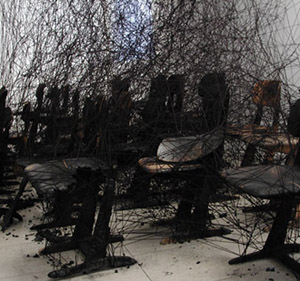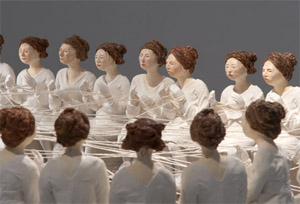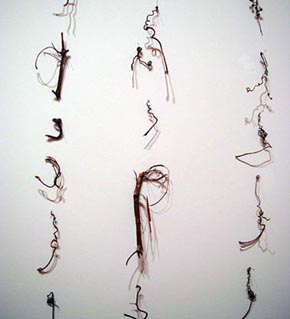Threading the Gallery Scene
John Haberin New York City
Gallery-Going 2008: Amy Cutler, Cui Fei, and Other Tendrils
This was a very good year for basic black—especially taken one filament at a time. For Jonah Groeneboer, it can spin out entire dimensions beyond the visible, in what physicists call, naturally enough, string theory. For Chiharu Shiota, thread has the dark, confining associations of a spider's web and a musty attic. For Tomás Saraceno, its weave defines a welcoming public space, like an amusement park for entomologists.
In some much overpraised paintings, Angelo Filomeno has blended embroidery, Goth imagery, and a high surface sheen to present "Betrayed Witches." For others, however, weaving holds out the brighter ideal of integrating craft and feminism's grandmothers into the fine-art tradition. With Amy Cutler, it has overtones of witch trials and solidarity all at once, although her thread, like her mythic America, is white. For Cui Fei, thread-like, calligraphic fragments of wheat suggest nature's own private language. Are these worlds difficult for ordinary mortals to penetrate? Threading the gallery scene is like navigating between public and private fantasies—and between dark and light. 
Eye of the needle
For years Fred Sandback or Sheila Hicks has transformed empty space into color with a single thread, but what could sound more meager? Sure, art can celebrate the "Unmonumental," but must it settle for something so minimal? For Jonah Groeneboer and Chiharu Shiota, not even three dimensions suffice. Groeneboer's threads claim to span four dimensions, while Shiota spins black thread into claustrophobic chambers of the mind.
Sandback's tilted rectangles at Dia:Beacon cross large galleries and open passages. With just four strands, he gives the illusion of solid planes and volumes, much as James Turrell or Anthony McCall does with light. In different ways, these artists hold the viewer at a distance. The work's slow unfolding invites contemplation, while the illusion alone makes one hesitate to approach it. Installations these days, in contrast, have a habit of pressing in from all sides. Although one cannot touch the fragile art object, Groeneboer and Shiota both trap the viewer somewhere just off-center.
Groeneboer's first work in Measure comes closest to Sandback's geometries, with parallel threads that descend from floor and ceiling. Densely packed, irregularly spaced, and held down by shiny metal tacks, they seem in motion, like a shower of gold. A more ambitious arrangement connects every corner of the back room, the slices simulating the projection of four-dimensional objects. One moves from wall to wall to take in a medium so close to invisible, and by moving one navigates the extra dimension. Not surprisingly, Groeneboer's drawings tend to fall flat. In sculpture, the work's open texture goes better with the concept of a dimension beyond the visible.
Shiota's largest work, Waiting, occupies a single corner, but it threatens that much more to take over the room. A dense snarl of black thread covers charred and faded chairs resting on the floor. It nearly entangles the visitor as well, especially on a busy Saturday. A somewhat more regular weave surrounds mirrors, placed on pedestals or hung on the wall. Like Joseph Cornell boxes, they fall somewhere between old closets, doll houses, scrapbooks, and misbegotten science experiments.
Shiota's black goes with her burnt wood and mutes the reflections. It owes more to Surrealism than to New York fashion sense, and it has almost too many ancestors. Many artists have used the materials or images of fire, ashes, scorched landscapes, broken homes, blackened timber, tar, or burning flesh. Think of Magdalena Abakanowicz, Alexander Lee, or Anselm Kiefer, to name just a few, while Lee Bontecou, and Ed Ruscha has executed precise drawings in gunpowder.
I thought, too, of the fire that consumes Miss Havisham's musty interior in Great Expectations, and Shiota does appear to identify the artist with the madwoman in the attic. Her thread also alludes to gender roles in the home, as for many of the artists recently in "The Feminine Mystique. And indeed in smaller works she sews directly into canvas. Even there, she comes close to bombast, but then this woman artist wants to have it all.
Bungee jumping
To get down to brass tacks, Groeneboer claims to represent slices of four dimensions. His press release adds some baggage about the uncertainty principle, which one might as well skip. Physicists only wish they could reconcile Einstein's spacetime with quantum mechanics. Shiota's theatricality, in turn, demands a little too much certainty. He asks light thread to take on the precise dimensions of a hypercube. She wants everything vague but heavy.
With each, however, drawing in thread has an active life. Her canvases might even recall Ghada Amer's, with Amer's pornographic images in thread translated into actual piercings. As Sandback knows so well, sometimes objects in two dimensions are the most confrontational of all. For another artist in black, however, confrontation is only a starting point.
Spun thread lends itself to more obvious metaphors than I can count, and Tomás Saraceno manages to work more than his share into a single title, Galaxies Forming Along Filaments, Like Droplets Along the Strands of a Spiders Web. Its very length suggests a tangle or an unfolding. After a few moments, but only after a few moments, visitors realize that they belong within the tangle, too. "Relational esthetics" would insist on it. The invitation borders on mere crowd pleasing, but has to make an effort to grasp it.
Black cords reach from the walls and floor to every side, without barring entrance to a large gallery. One can appreciate it as a mess or an almost tidy radial pattern, but one cannot quite step over or under it without touching. At its center, the lines organize themselves further into a kind of cocoon. This shape, too, looks undecided between chaos and regularity, but maybe nature is like that. One can take the longer cords as suspending the shape above ground, holding it down, or supplying its raw materials. One strains for a closer look.
One strains, that is, until it sinks in that more self-assured gallery-goers have come much closer already—but how? Is there a way into the maze? No, they just did what they had to do. For his cords, Saraceno's chose the thick, stretchable kind, and with a little push or pull one can fashion one's own route. With enough ingenuity, one might even launch oneself into the opposite corner, like a bungee jump. Maybe the cocoon got there the same way.
The cocoon consists of roughly two unequal spheres—or maybe failed buckyballs—with another nested inside. It also has no geometric relationship whatsoever to the radial lines. When it comes down to it, a self-generating hierarchy behind the leaps in scale is beside the point, and so are Saraceno's metaphors. This work does not bury itself deep inside one's head or bury the viewer inside. Spiders and people alike can relax and have fun. They should see what happens when two other artists take tendrils beyond the black.
Girls in their summer dresses
When I think of Amy Cutler, I remember the white space—not just of a drawing, but of a national agenda about to begin. She roots her drawings in rural America and the indefinite past. Without outlines, she creates a pattern of dark hair, high cheekbones, and gingham and hoop dresses. However, her women inhabit a field not of earth and sky but only of white. More hints of the paper peek through as highlights.
Cutler appeared in quick succession at the 2004 Biennial, the Brooklyn Museum's "Open House," and "Greater New York" at P.S. 1, and in no time the emerging artist had a following. Make that a cult following, appropriate to women that might themselves belong to a sect. They may take on animal heads, willingly or not, as in some unstated ritual. Often they act in concert, so that the subdued tones clump further together, as in a 2003 drawing titled Army of Me. In one new drawing, they lie side by side in the same bed. They do not look comfortable, but then they never have.
 They insist on an American myth, but one that art normally overlooks. For once, the landscape has no trace of real or urban cowboys, broad horizons or dark alleys. One cannot even say for sure whether the women are settling Puritan New England or the Wild West. A drawing's simplicity embeds them further in nature. It also leaves meanings wide open. Fans can read into the drawings whatever they want, and I suppose they do.
They insist on an American myth, but one that art normally overlooks. For once, the landscape has no trace of real or urban cowboys, broad horizons or dark alleys. One cannot even say for sure whether the women are settling Puritan New England or the Wild West. A drawing's simplicity embeds them further in nature. It also leaves meanings wide open. Fans can read into the drawings whatever they want, and I suppose they do.
Native craft may sound liberating, but all this display of pattern and decoration never simply affirms pre- or post-feminist success. Men could have forced her women into all this, or they could be forcing each other. Back at P.S. 1, the medium and the subject of women without men linked her to another emerging artist, Amy Wilson. However, Wilson's blonds adapted from Henry Darger think for themselves, about art and politics in the present, while Cutler's do not even want to have fun.
At the heart of the new show, a sculpture tilts the balance further from light to darkness. Small cast figures pack tightly around a wooden table. The women are knitting, in a frenzy of American industry, and yet they hold their hands apart for someone else to wield the needles. The white string confines them all in a web with scant promise of a fabric or a geometry. A similar dark weave seemed to prevent women from fleeing as a baby carriage fell from the sky in an earlier drawing that I myself have used to help picture a utopian feminism, Futile Flight.
The web also extends to the gallery floor, where the remainder of more than a hundred figurines kneel, lie, or sit facing front and center. Their summer dresses trail behind them, but only sometimes suggestive of flowing motion. At least as often the trail cuts off their legs, leaving only a stump, or merges with their butt like the tail of an animal. Spareness and ambiguity also translate into a kind of reserve. Here I wanted the sculpture larger, as a more ironic or frightening monument to feminism, but I admire the experiment all the same. Besides, to make up for the absence of paper, the women all wear white.
Waves of grain
It must be art's oldest dream, to let nature write itself. Like most dreams, however, it keeps shifting in the mind of the dreamer. Painting may have begun as a ritual encounter, with nature at once source, subject, and product. One can think of cave painting as a recycling of mud and ashes into humans, gods, and horses. Later, nature supposedly left its impress through the fidelity of the artist or more directly, in the artist's imagination, in photography, or in data-driven new media.
Like most dreams, too, this one has a certain distance from reality. In each case, nature leaves the dreamer with plenty of work to do and with responsibility for the outcome. Cui Fei calls her show "Manuscript of Nature," but Mother Nature would call it a creative collaboration. What looks like calligraphy may have multiple sources, sometimes within a single work. She might have drawn it freehand, fashioned it from plant tendrils, or let them cast their own shadow. What could pass for pottery shards amounts to gunk from the hardware store laid over wood.
Increasingly, she does take her materials from nature. The imagined archaeological dig already bears real oak leaves. Later work becomes more open and more given over to plants alone, like the tendrils affixed to the wall in regular columns. Bare stalks of wheat like twigs form one grid, blackened rose petals another. Stripping the branches recalls the making of a reed pen, the grid assemblage the preparation of handmade paper as for Zarina Hashmi. They maintain the illusion of writing and their place between the two dimensions of the support and the three dimensions of the materials.
 The allusion to writing appears in the shapes, but also in their near regularity. Cui Fei began as an abstract painter, and she still relies on formal structure and free gestures. One might get up close to see what Chinese looks like, only to find the artist's own patterns. She makes use of how Chinese runs from top to bottom, right to left. Along with the interplay between the artist's process and nature's, she draws on the contrast between ancient writing and transitory materials, China and New York. She says that she finds her materials in Central Park.
The allusion to writing appears in the shapes, but also in their near regularity. Cui Fei began as an abstract painter, and she still relies on formal structure and free gestures. One might get up close to see what Chinese looks like, only to find the artist's own patterns. She makes use of how Chinese runs from top to bottom, right to left. Along with the interplay between the artist's process and nature's, she draws on the contrast between ancient writing and transitory materials, China and New York. She says that she finds her materials in Central Park.
I cannot swear that Manhattan holds enough amber waves of grain to sustain human life, although it sure sustains a New Yorker's soul. Maybe it does not have to. The work suggests a rich cultural tradition or the possibility of organic growth, but it also makes plain nature's habit of drying out. The wheat has lost its bounty, and the roses could prick. Craft and vegetation may have particular meaning for feminist art, but these materials do not offer themselves to the touch. Crossing continents comes with its own promise of rebirth, but also its own risks of alienation.
Critical theory has developed the idea of art as text and philosophy as a kind of writing, but neither as easy to translate. In deconstruction, writing initiates an unending chain of signs and associations. Another woman artist, Michal Rovner, has similarly displayed what looks at first like archaeology and alphabets but up close might resemble naked bodies, oil rigs, or the genetic code. Cui Fei's work seems less grandiose and more personal. It depends more on a sense of humor than on sudden surprises. It also allows formalism and the illusion of nature's writing to get along just fine.

Angelo Filomeno ran at Galerie Lelong through April 12, 2008, Jonah Groeneboer at Bellwether through February 16, Chiharu Shiota at Goff + Rosenthal through March 10, Tomás Saraceno at Tanya Bonakdar, through April 19, Amy Cutler at Leslie Tonkonow, through April 5, and Cui Fei's "Manuscript of Nature" at Cheryl McGinnis through February 2. The review of Amy Cutler first appeared in slightly different form in the May 2008 issue of Artillery magazine.




